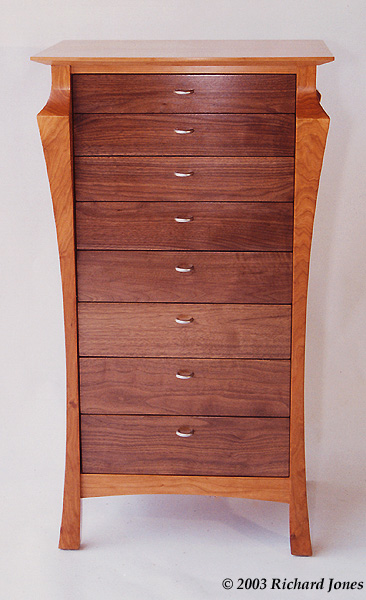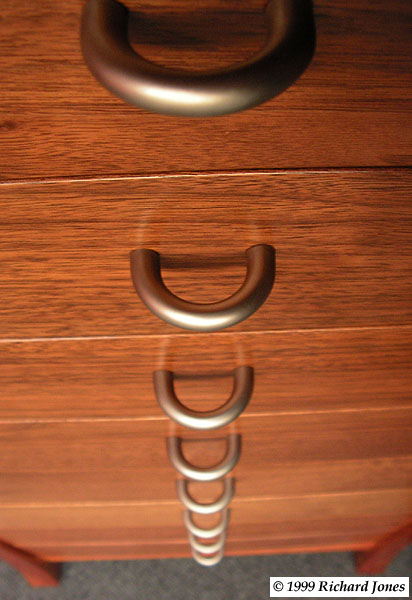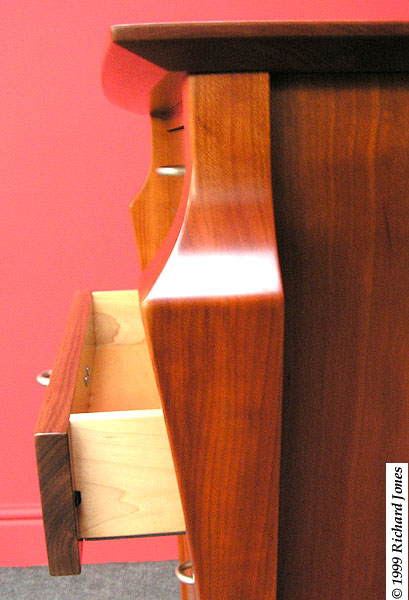
In Chris’s blog post, “The 10 Worst Mistakes I Made as a Beginner,” one mistake he mentioned was “buying the hardware at the end.” I added a comment to his blog to say that when I was studying furniture design and making at college in the early 1980s, a visiting lecturer, and furniture designer and maker Rupert Williamson, cited the mantra, “Design from the handles back.” He added, “Nipping down to the hardware shop at the last moment to carelessly buy some pug ugly wooden knobs for the chest of drawers you’ve made is all wrong.”

I immediately thought, How obvious. Essentially, all Rupert was really saying was to consider carefully what the viewer first sees because that first look either draws the viewer in or repels them. Every other part of the design is important of course, including what’s not seen initially along with the technicalities of construction and the fulfillment of other design criteria whether they be aesthetic, practical, cost, material choices and so on. The first look evokes a reaction, e.g., “ooh nice,” “hmm?” or “eeyeuch!” leading to further examination, pausing and moving along.
Earlier in my career, an element of my production included designing furniture for display in galleries and furniture shows, and the cabinet used to illustrate this text is an example. Exhibition pieces project your design ability and style, generate commissions, and are themselves salable. The variation of the cabriole leg style used in this piece was the design motif that initiated the design development; this leg form had already featured in tables, chairs and beds but I wanted to see if it could be used successfully in a cabinet.
Designing for shows is both liberating and restricting; you can make anything you like, but will anyone else appreciate it? In this case, with just the leg form as a starting point, there were no pre-existing design constraints, apart from the piece potentially having appeal to categories such as homeowners, interior designers and so on. With speculative pieces, I find it helpful to invent a realistic end-use, perhaps a need of one’s own. Here I settled on “storage” as the vague generalised end function. This forced concentration on the storage role and discouraged flights of fancy which were filed in the “maybe for later” category.
General proportions, i.e., width, depth, plus incorporation of the cabriole leg profile were resolved first through a mixture of technical decisions and sketching. The early design development soon led to the decision that the cabinet would be a nest of drawers in a free-standing cabinet – drawers can always find a purpose. Technical decisions were required. How many drawers, and how should they move? Visible wooden drawer dividers between drawer fronts, or not? Proprietary drawer slides? Planted or integral drawer fronts? Exposed horizontal dividers visible between drawer fronts were ruled out to reduce the quantity of cluttered horizontal lines. Full-extension undermount metal drawer slides were chosen because they are quite inconspicuous and allow the drawer to fill most of the internal cabinet width; they also give full and clear access to the drawer box. There are always arguments for and against proprietary slides, but I concluded they were a good choice.
The cabriole leg form and the curves in it, long and sweeping below the shoulder, and above it short and tightly arced, informed other elements of the visual impact – for instance, the bottom 100mm or so of the leg’s inner face is also curved, as are the bottom edges of the lower front rail, and the bottom edge of the side panel. The top has a shallow bevel worked on the underside to show a slim edge, and the front edge is gently arced.
But what about the maxim to “design from the handles back?” This hadn’t been forgotten and I’d decided that proprietary pulls would be used rather than making wooden pulls. Several possibilities were considered with the eventual choice being a U-shaped bronzed pull that picks up the similar half U-shaped curve above the knee of the leg. The bronze colour worked well, in my judgement, with the chosen wood, i.e., the visible walnut and cherry. Alternative colours available for the pulls were black or bright chrome, which I rejected because the softer or mellow bronze worked subtly with the wood colours. As a side note, the drawer boxes were made of hard maple with maple veneered plywood drawer bottoms, primarily to present a clean and light interior.

Eventually, a presentation drawing was worked up, not drawn with meticulous care maybe, but good enough for me as the customer. This was followed by creating an orthographic projection, from which an estimate, a cutting list and hardware list were extracted. From there it was just a case of buying the materials and building the cabinet, which leads to another useful maxim: Never assume the hardware is available unless you have it in stock. I’ve known a few makers get into a bit of a pickle because they’ve built a piece thinking they’ll buy the chosen hardware at a later date, only to find, too late, that the selected item has been discontinued and no old stock is available.

Is all of the above the recipe for successful design development? I’d say not really, but it does highlight the usefulness of the “design from the handles back” maxim. As to what happened to the cabinet? Well, it was exhibited at shows and galleries for a few years but never found a buyer. It did, however, generate several orders because people spotted it, liked it, and commissioned me to make something either based on it or very different. So, it earned its money for me and eventually I retired it from its exhibiting role and found a place in my own home – its drawers are stuffed with all sorts of things, so yes, drawers do always find a use.
— Richard Jones, author of “Cut & Dried: A Woodworker’s Guide to Timber Technology“
/*<![CDATA[*/
(function () {
var scriptURL = 'https://sdks.shopifycdn.com/buy-button/latest/buy-button-storefront.min.js';
if (window.ShopifyBuy) {
if (window.ShopifyBuy.UI) {
ShopifyBuyInit();
} else {
loadScript();
}
} else {
loadScript();
}
function loadScript() {
var script = document.createElement('script');
script.async = true;
script.src = scriptURL;
(document.getElementsByTagName('head')[0] || document.getElementsByTagName('body')[0]).appendChild(script);
script.onload = ShopifyBuyInit;
}
function ShopifyBuyInit() {
var client = ShopifyBuy.buildClient({
domain: 'lost-art-press-test.myshopify.com',
storefrontAccessToken: 'f83226aac752f3a8e262f8a8273c9739',
});
ShopifyBuy.UI.onReady(client).then(function (ui) {
ui.createComponent('product', {
id: '578845933631',
node: document.getElementById('product-component-1643727283303'),
moneyFormat: '%24%7B%7Bamount%7D%7D',
options: {
"product": {
"styles": {
"product": {
"@media (min-width: 601px)": {
"max-width": "calc(25% – 20px)",
"margin-left": "20px",
"margin-bottom": "50px"
}
},
"button": {
"font-size": "14px",
"padding-top": "15px",
"padding-bottom": "15px",
"border-radius": "11px",
"padding-left": "22px",
"padding-right": "22px"
},
"quantityInput": {
"font-size": "14px",
"padding-top": "15px",
"padding-bottom": "15px"
}
},
"text": {
"button": "Add to cart"
}
},
"productSet": {
"styles": {
"products": {
"@media (min-width: 601px)": {
"margin-left": "-20px"
}
}
}
},
"modalProduct": {
"contents": {
"img": false,
"imgWithCarousel": true,
"button": false,
"buttonWithQuantity": true
},
"styles": {
"product": {
"@media (min-width: 601px)": {
"max-width": "100%",
"margin-left": "0px",
"margin-bottom": "0px"
}
},
"button": {
"font-size": "14px",
"padding-top": "15px",
"padding-bottom": "15px",
"border-radius": "11px",
"padding-left": "22px",
"padding-right": "22px"
},
"quantityInput": {
"font-size": "14px",
"padding-top": "15px",
"padding-bottom": "15px"
}
},
"text": {
"button": "Add to cart"
}
},
"option": {},
"cart": {
"styles": {
"button": {
"font-size": "14px",
"padding-top": "15px",
"padding-bottom": "15px",
"border-radius": "11px"
}
},
"text": {
"total": "Subtotal",
"button": "Checkout"
}
},
"toggle": {
"styles": {
"count": {
"font-size": "14px"
}
}
}
},
});
});
}
})();
/*]]>*/